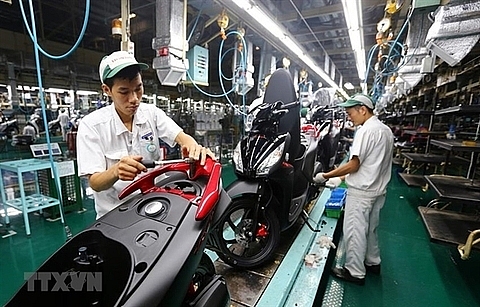Japanese firms choose Vietnam for production expansion
 |
| The Japan-invested Honda Vietnam plant in Vinh Phuc Province. - VNA/VNS Photo Danh Lam |
Speaking at a press conference on Thursday about the programme, Takeo Nakajima, chief representative of JETRO in Hanoi, said that among 30 Japanese firms selected by Japan’s Ministry of Economy, Trade and Industry (METI) from 124 applicants to provide supports to expand production in ASEAN, 15 selected Vietnam.
This demonstrated the huge attractiveness and positive prospects of the Vietnamese economy, he said, adding that the successful containment of the COVID-19 pandemic was an important factor that drew Japanese investors to Vietnam.
In the long term, the expansion into Vietnam also aims to help the Japanese firms take opportunities from origin rules of free trade agreements in which Vietnam is a member.
Within the Japanese government’s support programme, each Japanese firms would receive financial assistance from 1 million yen (US$9,400) to 5 billion yen, depending on their project scale.
Takeo noted that this unprecedented programme was an effort to expand production and diversify value chains, not a production shift out of China. Products would be made in both Vietnam and China to reduce risks when any value chains were disrupted by COVID-19, he said.
Takeo said the process of diversifying value chains by the Japanese enterprises was occurring earlier, adding that the pandemic was requiring firms to expand their production to two to three destinations to avoid disruption in supply chains despite higher production costs.
Vietnam was among their top choices, given the country’s success in containing the virus, improving investment climate, low production costs and export tariff incentives to major markets.
Race for FDI
Half of the METI-supported firms chose Vietnam as a destination for expansion, a figure that would shock other countries in the region, forcing them to strive to improve the investment climate to attract foreign direct investment (FDI), Takeo said.
He said there was a race to attract FDI among ASEAN countries, with countries with high productions costs like Malaysia, Singapore and Thailand part of it.
Although Vietnam has lower production costs, labour and land costs are rising and low production costs could no longer be the country's competitive advantage, he said.
“Vietnam needs to create other competitive advantages rather than low production cost,” he added.
Takeo also pointed out problems in Vietnam such as low local procurement rates, and poorly-developed supporting industries, which must be tackled in the race to attract FDI.
There was also a risk of labour shortage when a wave of foreign companies invested in the country.
Takeo also urged Vietnamese firms to strive to meet Japanese firms’ requirements to participate in supply chains.
Currently, restrictions in travelling between Vietnam and Japan are also affecting expansion projects from Japanese firms.
Economist Nguyen Duc Thanh said the race to attract FDI was becoming fiercer and Vietnam still needed to make efforts to resolve a number of problems to attract investors, including improving labour quality and the infrastructure system as well as hastening administrative reforms and tackling corruption.
What the stars mean:
★ Poor ★ ★ Promising ★★★ Good ★★★★ Very good ★★★★★ Exceptional
 Tag:
Tag:
Related Contents
Latest News
More News
- Human-centred governance seen as key to AI development (December 19, 2025 | 18:19)
- Top 10 notable events of Vietnam’s industry and trade sector in 2025 (December 19, 2025 | 14:00)
- Tungsten surges to 12-year high as world enters a new 'black gold' race (December 18, 2025 | 17:27)
- Vietnam’s coffee exports set new record despite price pressures (December 18, 2025 | 17:13)
- Garment and textile sector seeks new growth after volatile year (December 18, 2025 | 17:01)
- VinSpeed and Siemens strengthen cooperation for high-speed rail development (December 18, 2025 | 16:53)
- High-tech adoption for TH true MILK (December 18, 2025 | 13:39)
- Takeda supports health resilience amid climate change challenges (December 18, 2025 | 12:39)
- Mondelez Kinh Do - a chapter of purpose-led leadership in Vietnam (December 18, 2025 | 09:44)
- VNPAY services receive the highest-level PCI DSS international security certificates for six consecutive years (December 17, 2025 | 23:47)























 Mobile Version
Mobile Version